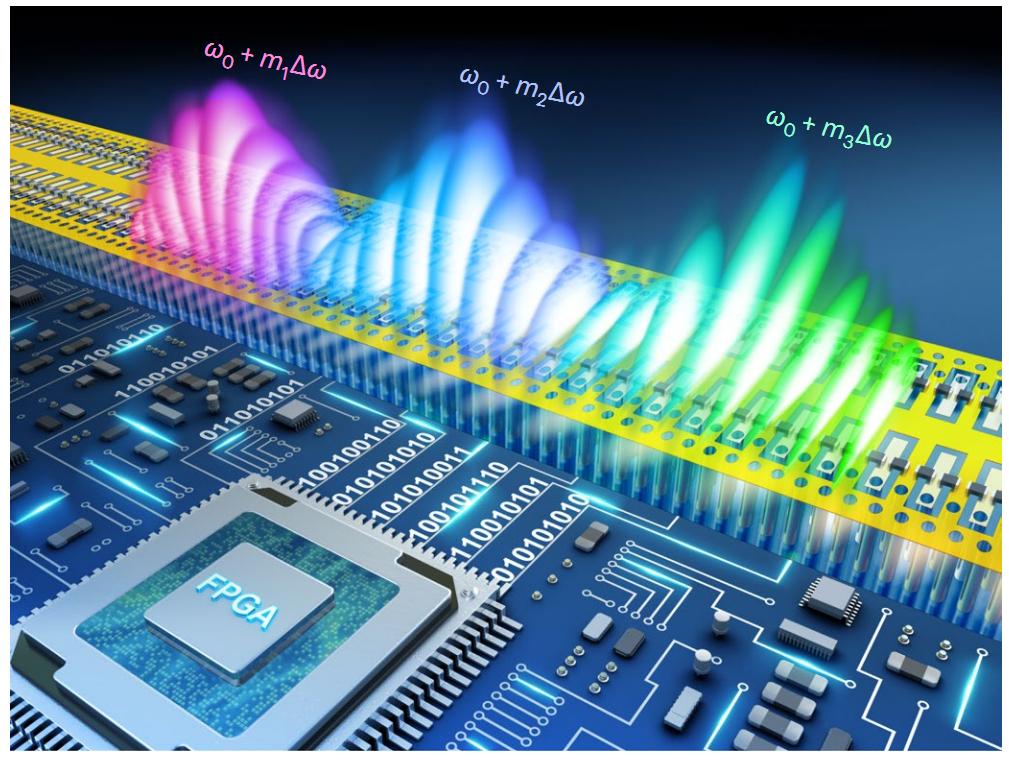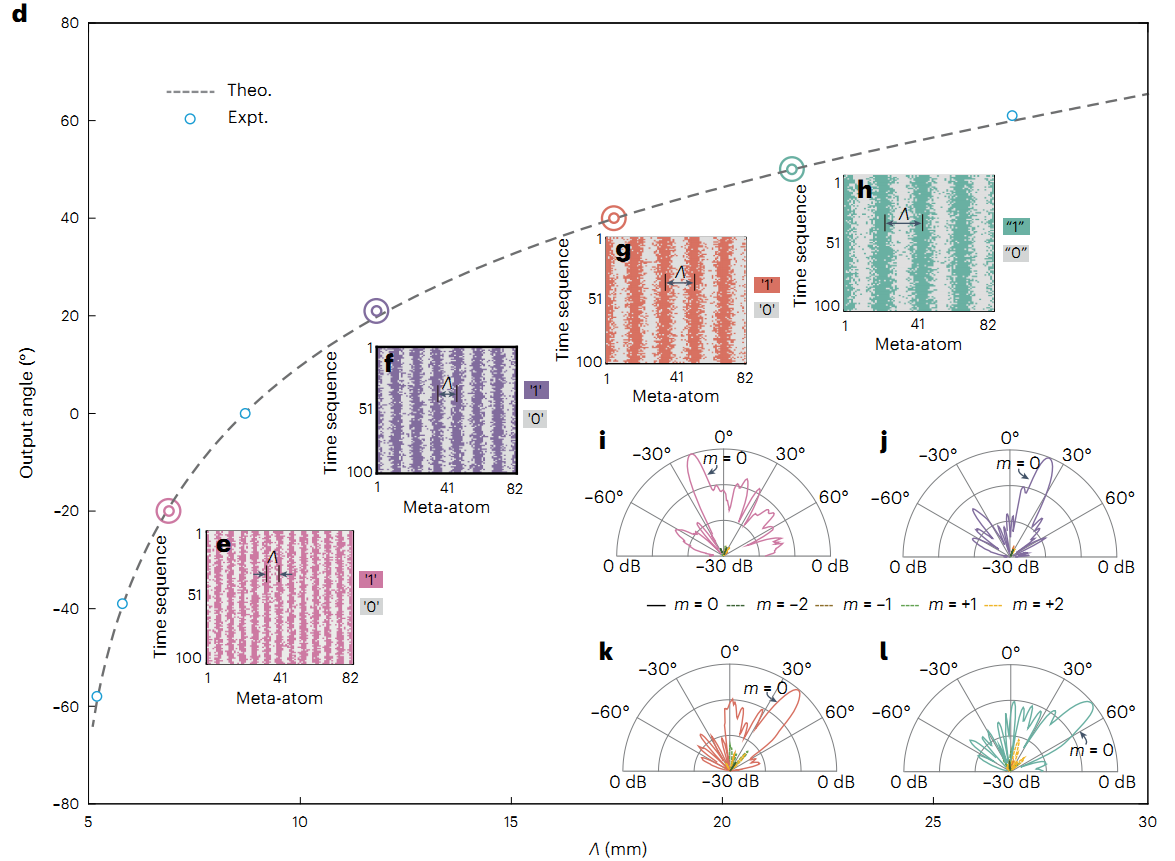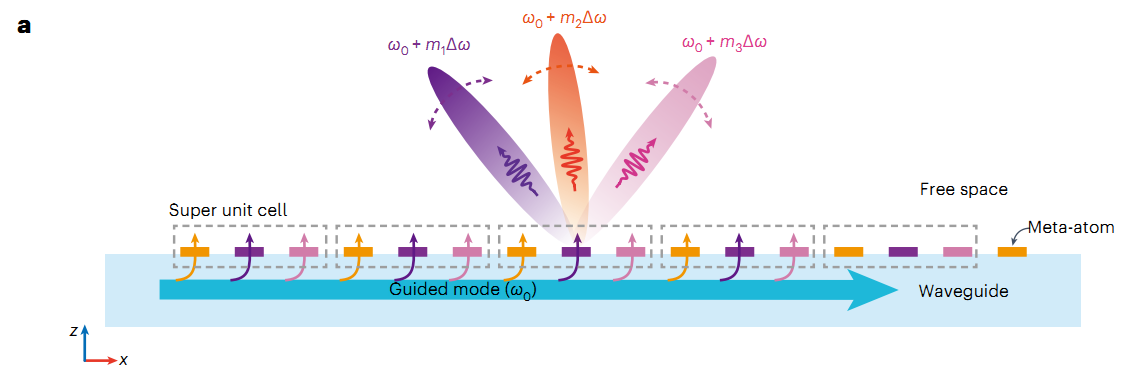A collaborative research team co-led by Prof. Chi Hou Chan (State Key Laboratory of Terahertz and Millimeter Waves, City University of Hong Kong), Academician Tie Jun Cui, and Prof. Qiang Cheng (State Key Laboratory of Millimeter Waves, Institute of Electromagnetic Space, Southeast University) proposed a novel waveguide-integrated space-time-coding (STC) metasurface antenna with the unique self-filtering property. The STC metasurface antenna can realize complicated wave manipulation in space and frequency domains by simply switching the meta-atoms between radiating and non-radiating states. The findings were published in the prestigious journal Nature Electronics under the title “Sideband-Free Space-Time-Coding Metasurface Antennas” [1]. Dr. Geng-Bo Wu and Dr. Jun Yan Dai are the co-first authors of the paper. Dr. Jun Yan Dai, Prof. Qiang Cheng, Academician Tie Jun Cui, and Prof. Chi Hou Chan are the corresponding authors.
Research Background
While the frequency spectrum of the fifth-generation (5G) wireless communications has not yet been fully utilized by the service providers, the race for 6G R&D among the leading information and communications technology (ITC) companies and academic institutions is gaining momentum. Reconfigurable intelligent surface (RIS) is a new type of artificial electromagnetic (EM) metasurface that can flexibly manipulate the frequency, amplitude, phase, polarization, and propagation direction of EM waves [2]. RIS is widely considered as a key enabler for next-generation 6G wireless communications due to its lightweight, power-efficient, and cost-efficient advantages. Especially, spatiotemporally modulated metasurfaces introduce the time as an additional design degree of freedom, greatly enhancing the wave controllability and expanding their applications [3]. However, the time modulation will generate unwanted harmonic frequencies, known as sidebands. These sidebands carry part of the radiated EM energy and interfere with the useful channels, leading to spectrum pollution. Sideband pollution is an open challenge that hinders the wide-spreading applications of spatiotemporally modulated metasurfaces [4] and time-modulated antenna arrays [5].

Fig. 1. Conceptual illustration of the STC metasurface antenna.
Research Highlight
Most spatiotemporally modulated metasurfaces are reflective/transmitted structures in open literature, whose input and output are both free-space EM waves. The team proposed a novel waveguide-integrated STC metasurface antenna that the metasurface is coating on the top of the waveguide (Fig. 1). PIN diode is incorporated into each meta-atom, whose radiation state can be switched between radiating and non-radiating states according to the control signal from an FPGA. By simply loading different 1-bit STC matrixes, the metasurface antenna can convert the guided waves into free-space waves with programmable frequency and momentum properties.

Fig. 2. STC metasurface antenna for high-efficiency frequency conversion.
The collaboration team first developed a theoretical model to predict the radiation characteristics of the STC metasurface. The periodical time modulation leads to non-linear effects and the generation of harmonic frequencies. Nevertheless, only the target harmonic can radiate into the free space due to the matching phase. In contrast, other undesired harmonics are highly suppressed in both free space and waveguide due to the tremendous momentum mismatch (Fig. 2). In this manner, the waveguide-integrated STC metasurface antenna can achieve high-efficiency frequency conversion with self-filtering property.

Fig. 3. STC metasurface antenna for beam scanning at the fundamental frequency.

Fig. 4. STC metasurface antenna for multi-harmonic independent control.
The key to realizing high-directivity beam for AM leaky-wave antenna is to form a sinusoidal amplitude distribution along the waveguide aperture [6]. This can be achieved by tuning the width of the spoof surface plasmon polariton (SSPP) transmission line. However, the radiation characteristics cannot be varied post-fabrication [7]. The team leveraged the time-average effect of the time modulation technology to form an equivalent sinusoidal amplitude distribution along the length of the waveguide such that a high-directivity beam can be generated at the fundamental frequency (Fig. 3). The STC metasurface antenna can also simultaneously and independently manipulate multiple harmonic frequencies by leveraging the sub-wavelength property of the meta-atom (Fig. 4). The multi-harmonic radiation increases the number of communication channels, which can find wide applications in multi-target detection and multi-user wireless communications.
Compared to the conventional free-space spatiotemporally modulated metasurfaces, the proposed STC metasurface antenna has many appealing features, including simple 1-bit switching, frequency and momentum manipulations, proof from sideband pollution, and potential on-chip integration. The technology can enable a series of applications in next-generation wireless communications, cognitive radar, and real-time imaging.
Research Team
Tie Jun Cui, Prof. Cui is the Academician of the Chinese Academy of Sciences and a Chief Professor of Information Science and Engineering at Southeast University. He is currently the Director of the State Key Laboratory of Millimeter Waves, Southeast University, and the Founding Director of the Institute of Electromagnetic Space, Southeast University. He was elected an IEEE Fellow in 2014, with the citation of “For Contributions to Microwave Metamaterials and Computational Electromagnetics”. He received the Young Scientist Award from the International Union of Radio Science in 1999; the Cheung Kong Professor by the Ministry of Education, China, in 2001; the National Science Foundation of China for Distinguished Young Scholars in 2002; the Natural Science Award (First Class) from the Ministry of Education, China, in 2011; and the National Natural Science Awards of China (Second Class, Twice) in 2014 and 2018.
Chi Hou Chan, Prof. Chan is a Chair Professor of Electronic Engineering at CityU. He is currently the Director of the State Key Laboratory of Terahertz and Millimeter Waves, CityU. He was elected an IEEE Fellow in 2002, with the citation of “For Contributions to Computational Electromagnetics.” He received the 2019 IEEE Antennas and Propagation Society Harrington-Mittra Computational Electromagnetics Award and the 2019 Distinguished Alumni Award from the Department of Electrical and Computer Engineering, University of Illinois at Urbana-Champaign.
Qiang Cheng, Prof. Cheng is a Young Chief Professor of Information Science and Engineering at Southeast University. He is currently the Deputy Director of the State Key Laboratory of Millimeter Waves, Southeast University. He received the National Science Foundation of China for Distinguished Young Scholars; the Young Cheung Kong Scholar by the Ministry of Education, China; the first batch of Distinguished Youth Foundation of Jiangsu Province; the New Century Talent Support Program of the Ministry of Education; the “333” Talent Project of Jiangsu Province; the six Talent Peak Programs of Jiangsu Province; the National Natural Science Awards of China (Second Class, Twice) in 2014 and 2018; the Natural Science Award (First Class) from the Ministry of Education, China, in 2011; the Top Ten Scientific Advances in China in 2010, and the top Ten scientific and technological Advances in China's higher Education Institutions in 2021.
Jun Yan Dai, Dr. Dai is currently an Associate Professor with the State Key Laboratory of Millimeter Waves, Southeast University. He was a Postdoctoral Fellow with the State Key Laboratory of Terahertz and Millimeter Waves, CityU. His research interests include metasurfaces, reconfigurable intelligent surfaces, space-time modulation technology, and wireless communication systems.
Geng-Bo Wu, Dr. Wu is currently a Postdoctoral Research Fellow with the State Key Laboratory of Terahertz and Millimeter Waves, CityU. His research interests include millimeter-wave and terahertz antennas, metasurfaces and their applciations in communications and imaging.
References
G. B. Wu, J. Y. Dai, Q. Cheng, T. J. Cui, and C. H. Chan, “Sideband-free space-time-coding metasurface antennas,” Nature Electronics, 2022. doi: 10.1038/s41928-022-00857-0
Q. Cheng, L. Zhang, J. Y. Dai, W. Tang, J. C. Ke, S. Liu, J. C. Liang, S. Jin, and T. J. Cui, “Reconfigurable intelligent surfaces: Simplified-architecture transmitters—from theory to implementations,” Proceedings of the IEEE, vol. 110, no. 9, pp. 1266-1289, 2022.
J. Y. Dai, et al., “High‐efficiency synthesizer for spatial waves based on space‐time‐coding digital metasurface,” Laser Photonics Rev., vol. 14, no. 6, pp. 1900133, 2020.
J. Y. Dai, J. Zhao, Q. Cheng, and T. J. Cui, “Independent control of harmonic amplitudes and phases via a time-domain digital coding metasurface,” Light Sci. Appl., vol. 7, no. 1, pp. 1-10, 2018.
S. Yang, Y. B. Gan, A. Qing, and P. K. Tan, “Design of a uniform amplitude time modulated linear array with optimized time sequences,” IEEE Trans. Antennas Propag., vol. 53, no. 7, pp. 2337-2339, 2005.
G. B. Wu, Q.-L. Zhang, K. F. Chan, B.-J. Chen, and C. H. Chan, “Amplitude-modulated leaky-wave antennas,” IEEE Trans. Antennas Propag., vol. 69, no. 7, pp. 3664-3676, 2020.
G. B. Wu, S.-Y. Zhu, S. W. Pang, and C. H. Chan, “Superheterodyne-inspired waveguide-integrated metasurfaces for flexible free-space light manipulation,” Nanophotonics, vol. 11, no. 20, pp. 4499-4514, 2022.


